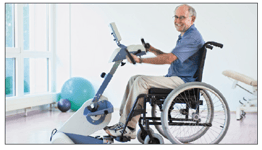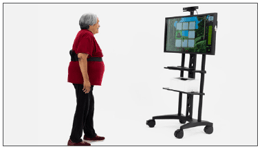Parkinson’s disease (PD) is a progressive neurodegenerative disorder often requiring therapy to address motor symptoms such as bradykinesia, rigidity, tremors, shuffling and freezing gait, poor postural control, and impaired balance. Exercise plays a key role in rehabilitation for this population with additional benefits being achieved by incorporating biophysical agents and advanced technologies. Research demonstrates that exercise improves motor skill performance, which may be enhanced with cognitive engagement through feedback, cueing, dual-tasking training, and motivation (Petzinger, et al., 2013).
OmniCycle® Considerations:
Research:
- High-intensity aerobic exercise (cycle or walk, 3x/week, 60-80%HRR, x 30-40 min, 5-10 min warm-up/cool-down) should be integrated into an exercise regimen. (Alberts & Rosenfeldt, 2020)
- Forced exercise with motor-assisted cycling (30-40 min, at 80-90 rpms, 5-10 min warm-up/cool-down) has been shown to improve motor function. (Miner, et al., 2020)
 Facilitate proper sitting posture throughout activity.
Facilitate proper sitting posture throughout activity.- Consider interval training to allow higher intensity with less fatigue.
- Use forced cycling at higher speed compared to self-selected pace.
- Integrate biofeedback activities (Soccer, Porcupine, or Traffic Jam) to provide visual/auditory cues, changes in speed/direction, and dual-task challenge.
OmniVR® Considerations:
Research:
- Virtual reality rehab resulted in significantly greater improvement in balance and gait (BBS, TUG, and FGA) compared to conventional physical therapy. (Feng, et al., 2019)
 In seated position, engage posture by varying support surface (firm, foam, balance ball).
In seated position, engage posture by varying support surface (firm, foam, balance ball).- Vary speed with gait (Fox, Wolf, Stroll).
- Practice multi-directional movement (Mole, Flower Garden, Vegetable Garden).
- Progress to stepping over and avoiding obstacles (Stroll).
- Perform squatting to facilitate picking something up from the floor (Vegetable Garden).
OmniVersa® Patterned Electrical Neuromuscular Stimulation (PENS) Considerations:
Research:
- Sensory electrical stimulation cueing during gait improved time to complete walking task and number of freezing gait episodes. (Rosenthal, et al., 2018)
 Use PENS UE and LE patterns to facilitate trunk and extremity exercise for improved posture control, strength, and coordination; apply during goal-oriented tasks when feasible.
Use PENS UE and LE patterns to facilitate trunk and extremity exercise for improved posture control, strength, and coordination; apply during goal-oriented tasks when feasible.- Use PENS cycle or walk protocol to provide sensory/motor input to the CNS for gait initiation, symmetry, and cadence; vary speed of protocols.
References:
Alberts, J. L., & Rosenfeldt, A. B. (2020). The Universal Prescription for Parkinson’s Disease: Exercise. Journal of Parkinson’s disease, 10(s1), S21–S27. https://doi.org/10.3233/JPD-202100
Feng, H., Li, C., Liu, J., Wang, L., Ma, J., Li, G., Gan, L., Shang, X., & Wu, Z. (2019). Virtual Reality Rehabilitation Versus Conventional Physical Therapy for Improving Balance and Gait in Parkinson’s Disease Patients: A Randomized Controlled Trial. Medical Ccience Monitor: International Medical Journal of Experimental and Clinical Research, 25, 4186–4192. https://doi.org/10.12659/MSM.916455
Miner, D. G., Aron, A., & DiSalvo, E. (2020). Therapeutic effects of forced exercise cycling in individuals with Parkinson’s disease. Journal of the Neurological Sciences, 410, 116677. https://doi.org/10.1016/j.jns.2020.116677
Petzinger, G. M., Fisher, B. E., McEwen, S., Beeler, J. A., Walsh, J. P., & Jakowec, M. W. (2013). Exercise-enhanced neuroplasticity targeting motor and cognitive circuitry in Parkinson’s disease. The Lancet. Neurology, 12(7), 716–726.
https://doi.org/10.1016/S1474-4422(13)70123-6
Rosenthal, L., Sweeney, D., Cunnington, A. L., Quinlan, L. R., & ÓLaighin, G. (2018). Sensory Electrical Stimulation Cueing May Reduce Freezing of Gait Episodes in Parkinson’s Disease. Journal of Healthcare Engineering, 2018,
4684925. https://doi.org/10.1155/2018/4684925
